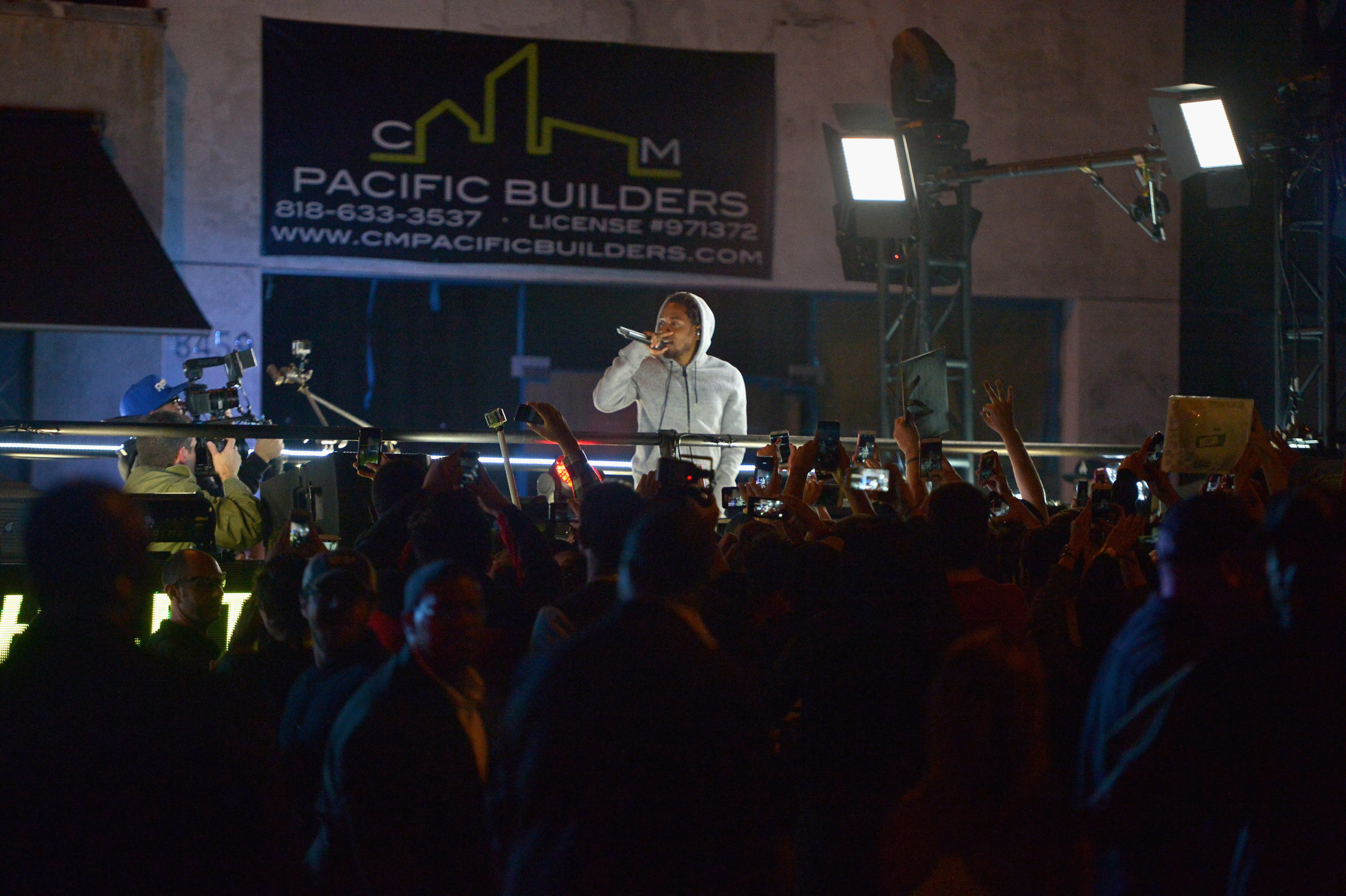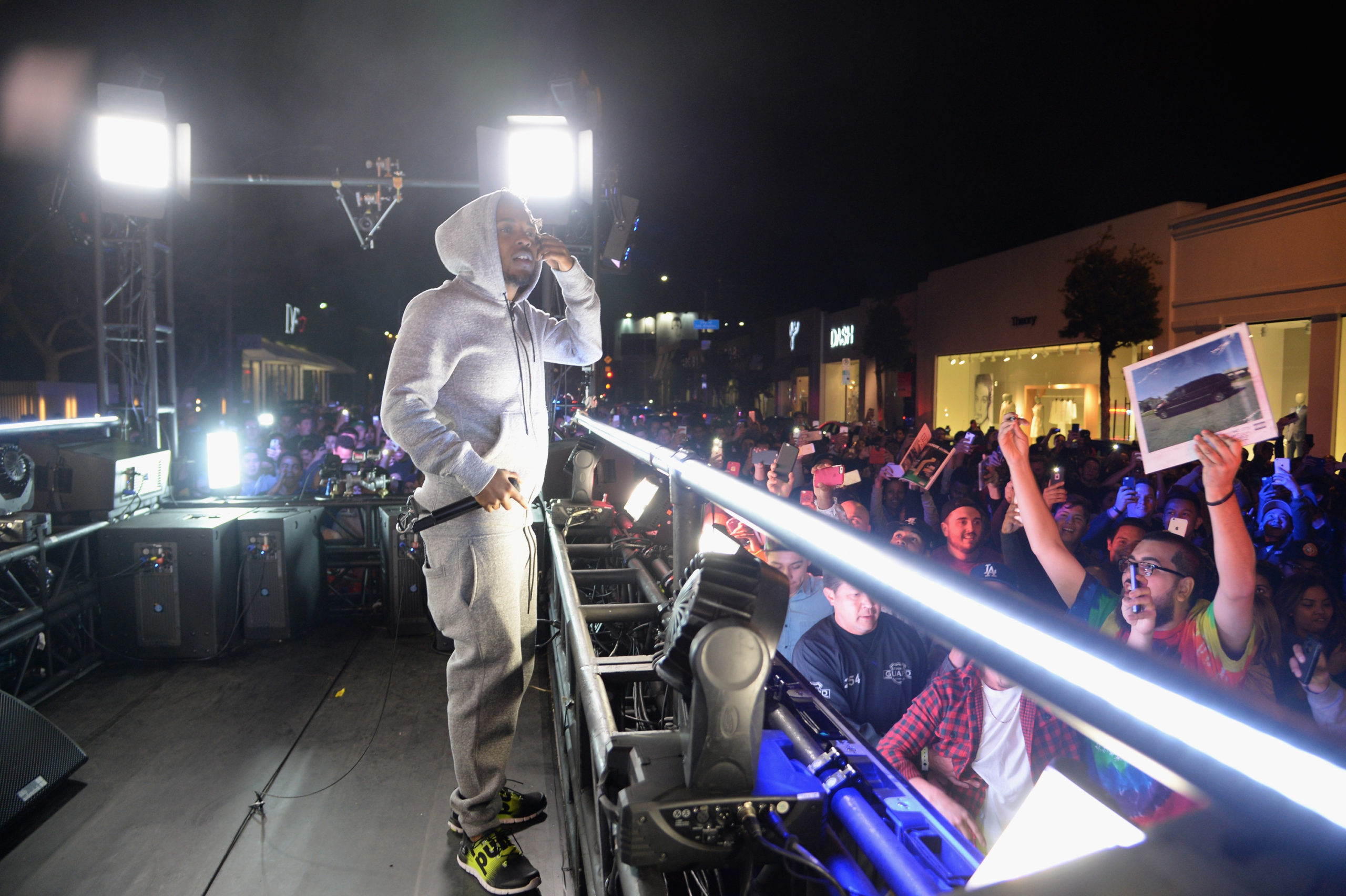My 3-Mile Run With Kendrick Lamar
I had to keep up with Kendrick Lamar but the task was proving difficult.
Lamar, the silver-tongued emcee whose thoughtful political and racial-themed raps have made him one of the most popular rappers in the world, was standing in the bed of an enormous truck. I, the tall, mildly athletic writer, was on foot behind him.
As part of a Reebok event promoting its new ZPump Fusion running shoe, Lamar, rocking a pair in lime green and black, was performing his hits, songs a few years old but engrained in hip-hop culture deep enough to be called classics: “Swimming Pools.” “The Art of Peer Pressure.” “Backseat Freestyle.” A band behind Lama swayed with the movements of the truck as it cruised through the once-serene streets of Los Angeles. The bass thumped, announcing Lamar’s presence from miles away.
What was supposed to be a light 3-mile jaunt through West Hollywood morphed into full-on pandemonium. With every turn the 16-wheeler took, from Sunset to North Crescent Heights to Melrose, the crowd grew behind it, picking up shrieking Lamar fans, confused bystanders and people who simply wanted to be a part of whatever was happening, sucking them in to the mass of energy.
With every new participant, the mass of people became harder to maneuver through and around. Avoiding parked cars, mailboxes and palm trees, I alternated between barely a jog and a brisk walk, attempting to take video with my iPhone. This was literally the most insane thing I’d ever been a part of. Other people around me were doing the same thing, and it was getting a little dicey. A girl who lost a shoe turned against the tide to retrieve it, risking being buried beneath thousands of feet. Fans drunk on Lamar’s raspy, energetic flow attempted to get closer to the truck, placing their hands on my back as their shoulders bounced me to the side to create a path.
From a hundred feet ahead, Lamar, his face as wrapped in the moment as we were, yelled into his microphone: “Are y’all still with me out there?” It was a rhetorical question. Of course we were.

As the caravan neared the end of its route, Lamar’s truck speeded up. With each block he passed, the rapper got further away from me. I broke into a sprint, careening past fans who didn’t expect a cardio workout to be a part of the experience and being passed by media members in much better shape than I was. My lungs were burning but I didn’t care. The greater the distance between me and the truck, the more the moment felt like it was ending. And I didn’t want it to end.
I caught up with Lamar before the truck made its final turn. As I ducked under a palm tree and brushed away beads of sweat barreling down my forehead like a salty waterfall, I saw a horde of fans pulsating in front of us, waving frantically, cell phones raised in the air. Lamar had tweeted out his location, and when the truck stopped, the event became a full-blown concert in the middle of Melrose.
“It was crazy. It was wild,” Lamar said later on. “In fact I had to keep my balance and keep up my energy. And you’ve got a bunch of kids jumping. It was crazy. It was a beautiful thing, though. I remember when it was 15 or 30 people at my shows. And now it’s thousands of kids chasing after me while I perform their favorite songs. I’m honored to make them feel good about themselves.”
When rappers talk about “running their city,” it’s usually more chest-puffing hyperbole than substance, but with Lamar, it was real. I mean, he literally rode through L.A. with a police escort, shutting down streets in one of the biggest cities on earth while his disciples followed him like he was the Pied Piper.
It was an unforgettable night with a transcendent artist, made better by the fact that Lamar himself was visibly moved by the energy. He said, “It’s a great feeling, because these are the people that have been rocking with me since my earliest mixtapes. Since before Section 80 all the way to now, To Pimp a Butterfly. It’s the same kids, so to still have that support in your own city, it feels good.”

The truck’s ignition was turned off, the lights were dimmed and the music stopped. The horde dispersed, and the streets of L.A. were quiet again, as if they hadn’t just been rolled over by a two-ton truck toting a legendary entertainer. But for a half-hour, I burned some calories while a live band provided me with a soundtrack. And I kept up with Kendrick Lamar.
RECOMMENDED FOR YOU
My 3-Mile Run With Kendrick Lamar
I had to keep up with Kendrick Lamar but the task was proving difficult.
Lamar, the silver-tongued emcee whose thoughtful political and racial-themed raps have made him one of the most popular rappers in the world, was standing in the bed of an enormous truck. I, the tall, mildly athletic writer, was on foot behind him.
As part of a Reebok event promoting its new ZPump Fusion running shoe, Lamar, rocking a pair in lime green and black, was performing his hits, songs a few years old but engrained in hip-hop culture deep enough to be called classics: “Swimming Pools.” “The Art of Peer Pressure.” “Backseat Freestyle.” A band behind Lama swayed with the movements of the truck as it cruised through the once-serene streets of Los Angeles. The bass thumped, announcing Lamar’s presence from miles away.
What was supposed to be a light 3-mile jaunt through West Hollywood morphed into full-on pandemonium. With every turn the 16-wheeler took, from Sunset to North Crescent Heights to Melrose, the crowd grew behind it, picking up shrieking Lamar fans, confused bystanders and people who simply wanted to be a part of whatever was happening, sucking them in to the mass of energy.
With every new participant, the mass of people became harder to maneuver through and around. Avoiding parked cars, mailboxes and palm trees, I alternated between barely a jog and a brisk walk, attempting to take video with my iPhone. This was literally the most insane thing I’d ever been a part of. Other people around me were doing the same thing, and it was getting a little dicey. A girl who lost a shoe turned against the tide to retrieve it, risking being buried beneath thousands of feet. Fans drunk on Lamar’s raspy, energetic flow attempted to get closer to the truck, placing their hands on my back as their shoulders bounced me to the side to create a path.
From a hundred feet ahead, Lamar, his face as wrapped in the moment as we were, yelled into his microphone: “Are y’all still with me out there?” It was a rhetorical question. Of course we were.

As the caravan neared the end of its route, Lamar’s truck speeded up. With each block he passed, the rapper got further away from me. I broke into a sprint, careening past fans who didn’t expect a cardio workout to be a part of the experience and being passed by media members in much better shape than I was. My lungs were burning but I didn’t care. The greater the distance between me and the truck, the more the moment felt like it was ending. And I didn’t want it to end.
I caught up with Lamar before the truck made its final turn. As I ducked under a palm tree and brushed away beads of sweat barreling down my forehead like a salty waterfall, I saw a horde of fans pulsating in front of us, waving frantically, cell phones raised in the air. Lamar had tweeted out his location, and when the truck stopped, the event became a full-blown concert in the middle of Melrose.
“It was crazy. It was wild,” Lamar said later on. “In fact I had to keep my balance and keep up my energy. And you’ve got a bunch of kids jumping. It was crazy. It was a beautiful thing, though. I remember when it was 15 or 30 people at my shows. And now it’s thousands of kids chasing after me while I perform their favorite songs. I’m honored to make them feel good about themselves.”
When rappers talk about “running their city,” it’s usually more chest-puffing hyperbole than substance, but with Lamar, it was real. I mean, he literally rode through L.A. with a police escort, shutting down streets in one of the biggest cities on earth while his disciples followed him like he was the Pied Piper.
It was an unforgettable night with a transcendent artist, made better by the fact that Lamar himself was visibly moved by the energy. He said, “It’s a great feeling, because these are the people that have been rocking with me since my earliest mixtapes. Since before Section 80 all the way to now, To Pimp a Butterfly. It’s the same kids, so to still have that support in your own city, it feels good.”

The truck’s ignition was turned off, the lights were dimmed and the music stopped. The horde dispersed, and the streets of L.A. were quiet again, as if they hadn’t just been rolled over by a two-ton truck toting a legendary entertainer. But for a half-hour, I burned some calories while a live band provided me with a soundtrack. And I kept up with Kendrick Lamar.












